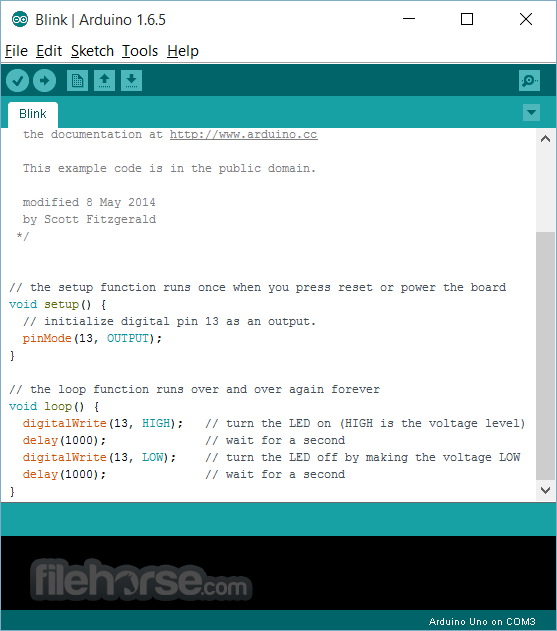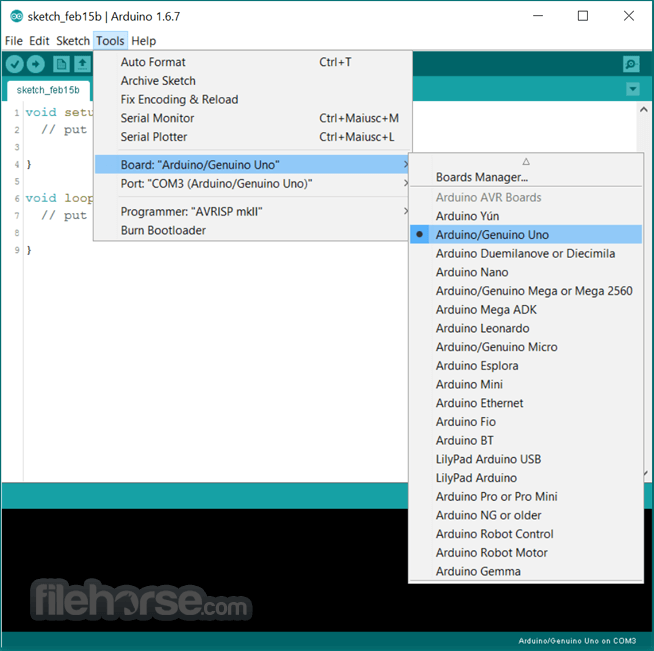-
Latest Version
Arduino 2.3.6 LATEST
-
Review by
-
Operating System
Windows 10 (64-bit) / Windows 11
-
User Rating
Click to vote -
Author / Product
-
Filename
arduino-ide_2.3.6_Windows_64bit.exe
Arduino IDE, short for Arduino Integrated Development Environment, is an open-source software designed specifically for programming Arduino microcontrollers.
It provides an intuitive and user-friendly interface that simplifies the process of writing code for Arduino boards, making it accessible to both beginners and experienced developers alike.
With the Arduino IDE Desktop, users can write, compile, and upload their code to Arduino boards, enabling them to create a wide range of projects, from simple LED blinking to complex robotics.
Arduino with Chromebook
Programming Arduino from a Chromebook has become possible through the utilization of the Arduino Web Editor on the Arduino Cloud platform. Unfortunately, the desktop version of the Arduino IDE is not compatible with Chrome OS.
Arduino Web Editor
Embark on your coding journey online and securely store your sketches in the cloud. The latest iteration of the Arduino IDE boasts an extensive library collection and offers compatibility with the latest Arduino boards, ensuring you have access to all the resources you need for your projects.
Highlights
Long-awaited new arduino-builder
This is a pure command-line tool that takes care of mangling the code, resolving library dependencies, and setting up the compilation units. It can also be used as a standalone program in a continuous-integration environment.
Pluggable USB core
Your Arduino can finally act as a lot of different USB devices without any need to change the core, thanks to the new modular architecture. Libraries based on the new subsystem are already being developed!
Serial plotter
You can now plot your data in real-time, as easily as writing Serial.println(analogRead(A0)) inside your loop.
New goodies
For library developers, like unlocked examples while developing an optional linkage into an archive.
ArduinoISP example
Has been improved a lot and now you can flash your AVR chip using ANY other board.
Both Libraries and Boards managers
Notify if a library/core can be updated with a simple popup – no more outdated code floating around!
Features
Editor: It offers a versatile code editor with syntax highlighting and autocompletion, making it easier to write and edit code.
Library Manager: Access a vast library of pre-written code snippets and libraries, saving time and effort in project development.
Board Manager: Seamlessly manage Arduino board configurations and install the necessary board definitions.
Serial Monitor: Monitor and debug projects by viewing real-time data sent over the serial port.
Integrated Examples: Gain inspiration and learn from a wide range of built-in example sketches that cover various functionalities and projects.
Third-Party Library Support: Extend the capabilities of Arduino IDE by integrating third-party libraries, expanding the available functionalities.
Version Control: Use the built-in version control system to track changes and manage different iterations of your code.
Plug-and-Play: Easily connect the boards to your computer, with automatic detection and configuration.
User Interface
It sports a clean and straightforward user interface. The main window is divided into three sections: the toolbar, the code editor, and the message area. The toolbar provides quick access to essential functions like uploading code, opening examples, and verifying code.
The code editor offers syntax highlighting, line numbering, and indentation, enhancing code readability. The message area displays compiler output and error messages, aiding in debugging.
Installation and Setup
Installing the app is a straightforward process. Simply download the latest version from the official website or FileHorse and run the installer.
The installation wizard will guide you through the necessary steps, including driver installation for communication with Arduino boards. Once installed, the Arduino IDE is ready to use.
How to Use
- Launch the Arduino IDE and select the appropriate Arduino board from the "Tools" menu.
- Write your code in the code editor, utilizing the available features like autocompletion and syntax highlighting.
- Use the library manager to include additional libraries required for your project.
- Connect your Arduino board to the computer via USB and select the appropriate port from the "Tools" menu.
- Click the "Upload" button to compile and upload your code to the board.
- Monitor the serial output using the built-in serial monitor to debug and observe real-time data.
Q: What is Arduino IDE?
A: Arduino Desktop is software used for programming Arduino microcontrollers, facilitating the creation of electronic projects.
Q: Can I use Arduino IDE with other microcontrollers?
A: While the program is primarily designed for Arduino boards, it can also be used with compatible microcontrollers like ESP8266 and ESP32.
Q: Is Arduino IDE compatible with Windows, Mac, and Linux?
A: Yes, the app is available for all major operating systems, including Windows, Mac, and Linux.
Q: Can I use external libraries with Arduino IDE?
A: Yes, it supports third-party libraries, allowing you to extend the functionality of your Arduino projects.
Q: Is the Arduino IDE suitable for beginners?
A: Yes, it provides a beginner-friendly environment, with extensive documentation and a large community for support.
Alternatives
Atmel Studio: Ideal for users working with Atmel microcontrollers, providing a comprehensive development environment with advanced debugging capabilities.
PlatformIO IDE for VSCode: A powerful alternative that supports multiple platforms and offers advanced features for professional developers.
MPLAB X IDE: Popular among users working with Microchip's PIC microcontrollers, offering a comprehensive development environment.
Visual Studio Code with Arduino Extension: A flexible and widely used code editor that can be extended with the Arduino extension to support Arduino development.
Pricing
The program is completely FREE and open-source, making it accessible to all users without any cost limitations.
System Requirements
- Operating System: Windows 7, 8, 10 or 11
- Processor: 1 GHz or faster
- RAM: 512 MB or more
- Disk Space: 150 MB for installation
- Beginner-friendly interface with a shallow learning curve
- Vast library of example sketches and third-party libraries
- Open-source and community-driven development environment
- Cross-platform compatibility
- Extensive documentation and active community support
- Limited advanced features compared to professional IDEs
- The interface may feel simplistic for experienced developers
- Occasional compatibility issues with certain board configurations
The Arduino IDE is a remarkable piece of software that empowers individuals to bring their electronic ideas to life. With its user-friendly interface, extensive library support, and wide compatibility with Arduino boards, it provides a solid foundation for both beginners and experienced developers to create innovative projects.
Whether you're a hobbyist, a student, or a professional, the Arduino is an invaluable tool that unlocks endless possibilities for creative expression and technological innovation.
Note: Requires the Arduino platform.
Also Available: Download Arduino for Mac
 OperaOpera 120.0 Build 5543.38 (64-bit)
OperaOpera 120.0 Build 5543.38 (64-bit) SiyanoAVSiyanoAV 2.0
SiyanoAVSiyanoAV 2.0 PhotoshopAdobe Photoshop CC 2025 26.8.1 (64-bit)
PhotoshopAdobe Photoshop CC 2025 26.8.1 (64-bit) BlueStacksBlueStacks 10.42.86.1001
BlueStacksBlueStacks 10.42.86.1001 CapCutCapCut 6.5.0
CapCutCapCut 6.5.0 Premiere ProAdobe Premiere Pro CC 2025 25.3
Premiere ProAdobe Premiere Pro CC 2025 25.3 PC RepairPC Repair Tool 2025
PC RepairPC Repair Tool 2025 Hero WarsHero Wars - Online Action Game
Hero WarsHero Wars - Online Action Game SemrushSemrush - Keyword Research Tool
SemrushSemrush - Keyword Research Tool LockWiperiMyFone LockWiper (Android) 5.7.2
LockWiperiMyFone LockWiper (Android) 5.7.2




Comments and User Reviews